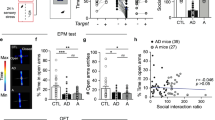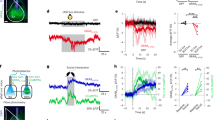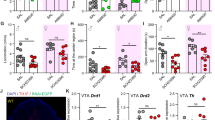Abstract
The bed nucleus of the stria terminalis (BNST) is a brain region important for regulating anxiety-related behavior in both humans and rodents. Here we used a chemogenetic strategy to investigate how engagement of G protein-coupled receptor (GPCR) signaling cascades in genetically defined GABAergic BNST neurons modulates anxiety-related behavior and downstream circuit function. We saw that stimulation of vesicular γ-aminobutyric acid (GABA) transporter (VGAT)-expressing BNST neurons using hM3Dq, but neither hM4Di nor rM3Ds designer receptors exclusively activated by a designer drug (DREADD), promotes anxiety-like behavior. Further, we identified that activation of hM3Dq receptors in BNST VGAT neurons can induce a long-term depression-like state of glutamatergic synaptic transmission, indicating DREADD-induced changes in synaptic plasticity. Further, we used DREADD-assisted metabolic mapping to profile brain-wide network activity following activation of Gq-mediated signaling in BNST VGAT neurons and saw increased activity within ventral midbrain structures, including the ventral tegmental area and hindbrain structures such as the locus coeruleus and parabrachial nucleus. These results highlight that Gq-mediated signaling in BNST VGAT neurons can drive downstream network activity that correlates with anxiety-like behavior and points to the importance of identifying endogenous GPCRs within genetically defined cell populations. We next used a microfluidics approach to profile the receptorome of single BNST VGAT neurons. This approach yielded multiple Gq-coupled receptors that are associated with anxiety-like behavior and several potential novel candidates for regulation of anxiety-like behavior. From this, we identified that stimulation of the Gq-coupled receptor 5-HT2CR in the BNST is sufficient to elevate anxiety-like behavior in an acoustic startle task. Together, these results provide a novel profile of receptors within genetically defined BNST VGAT neurons that may serve as therapeutic targets for regulating anxiety states and provide a blueprint for examining how G-protein-mediated signaling in a genetically defined cell type can be used to assess behavior and brain-wide circuit function.
This is a preview of subscription content, access via your institution
Access options
Subscribe to this journal
Receive 12 print issues and online access
$259.00 per year
only $21.58 per issue
Buy this article
- Purchase on Springer Link
- Instant access to full article PDF
Prices may be subject to local taxes which are calculated during checkout





Similar content being viewed by others
References
Griebel G, Holmes A . 50 years of hurdles and hope in anxiolytic drug discovery. Nat Rev Drug Discov 2013; 12: 667–687.
Kessler RC, Chiu WT, Demler O, Walters EE . Prevalence, severity, and comorbidity of 12-month DSM-IV disorders in the National Comorbidity Survey Replication. Arch Gen Psychiatry 2005; 62: 617.
Kessler RC, Berglund P, Demler O, Jin R, Merikangas KR, Walters EE . Lifetime prevalence and age-of-onset distributions of DSM-IV disorders in the National Comorbidity Survey Replication. Arch Gen Psychiatry 2005; 62: 593.
Insel TR . Next-generation treatments for mental disorders. Sci Transl Med 2012; 4: 155ps19.
Calhoon GG, Tye KM . Resolving the neural circuits of anxiety. Nat Neurosci 2015; 18: 1394–1404.
Daniel SE, Rainnie DG . Stress modulation of opposing circuits in the bed nucleus of the stria terminalis. Neuropsychopharmacology 2016; 41: 103–125.
Lebow MA, Chen A . Overshadowed by the amygdala: the bed nucleus of the stria terminalis emerges as key to psychiatric disorders. Mol Psychiatry 2016; 21: 450–463.
Sun N, Cassell MD . Intrinsic GABAergic neurons in the rat central extended amygdala. J Comp Neurol 1993; 330: 381–404.
Dong H-W, Swanson LW . Organization of axonal projections from the anterolateral area of the bed nuclei of the stria terminalis. J Comp Neurol 2004; 468: 277–298.
Dong H-W, Swanson LW . Projections from bed nuclei of the stria terminalis, anteromedial area: cerebral hemisphere integration of neuroendocrine, autonomic, and behavioral aspects of energy balance. J Comp Neurol 2006; 494: 142–178.
Straube T, Mentzel H-J, Miltner WHR . Waiting for spiders: brain activation during anticipatory anxiety in spider phobics. Neuroimage 2007; 37: 1427–1436.
Mobbs D, Yu R, Rowe JB, Eich H, FeldmanHall O, Dalgleish T . Neural activity associated with monitoring the oscillating threat value of a tarantula. Proc Natl Acad Sci 2010; 107: 20582–20586.
Mobbs D, Petrovic P, Marchant JL, Hassabis D, Weiskopf N, Seymour B et al. When fear is near: threat imminence elicits prefrontal-periaqueductal gray shifts in humans. Science 2007; 317: 1079–1083.
Somerville LH, Whalen PJ, Kelley WM . Human bed nucleus of the stria terminalis indexes hypervigilant threat monitoring. Biol Psychiatry.; 2010; 68: 416–424.
Kim S-Y, Adhikari A, Lee SY, Marshel JH, Kim CK, Mallory CS et al. Diverging neural pathways assemble a behavioural state from separable features in anxiety. Nature 2013; 496: 219–223.
Jennings JH, Sparta DR, Stamatakis AM, Ung RL, Pleil KE, Kash TL et al. Distinct extended amygdala circuits for divergent motivational states. Nature 2016; 496: 224–228.
Yassa MA, Hazlett RL, Stark CEL, Hoehn-Saric R . Functional MRI of the amygdala and bed nucleus of the stria terminalis during conditions of uncertainty in generalized anxiety disorder. J Psychiatr Res 2012; 46: 1045–1052.
Fox AS, Shelton SE, Oakes TR, Davidson RJ, Kalin NH . Trait-like brain activity during adolescence predicts anxious temperament in primates. PLoS One 2008; 3: e2570.
Kalin NH, Shelton SE, Fox AS, Oakes TR, Davidson RJ . Brain regions associated with the expression and contextual regulation of anxiety in primates. Biol Psychiatry 2005; 58: 796–804.
Lee Y, Davis M . Role of the hippocampus, the bed nucleus of the stria terminalis, and the amygdala in the excitatory effect of corticotropin-releasing hormone on the acoustic startle reflex. J Neurosci 1997; 17: 6434–6446.
Walker DL, Davis M . Double dissociation between the involvement of the bed nucleus of the stria terminalis and the central nucleus of the amygdala in startle increases produced by conditioned versus unconditioned fear. J Neurosci 1997; 17: 9375–9383.
Waddell J, Morris RW, Bouton ME . Effects of bed nucleus of the stria terminalis lesions on conditioned anxiety: aversive conditioning with long-duration conditional stimuli and reinstatement of extinguished fear. Behav Neurosci 2006; 120: 324–336.
Kash TL . The role of biogenic amine signaling in the bed nucleus of the stria terminals in alcohol abuse. Alcohol 2012; 46: 303–308.
Kash TL, Pleil KE, Marcinkiewcz CA, Lowery-Gionta EG, Crowley N, Mazzone C et al. Neuropeptide regulation of signaling and behavior in the BNST. Mol Cells 2015; 38: 1–13.
Cecchi M, Khoshbouei H, Javors M, Morilak DA . Modulatory effects of norepinephrine in the lateral bed nucleus of the stria terminalis on behavioral and neuroendocrine responses to acute stress. Neuroscience 2002; 112: 13–21.
Walker DL, Miles LA, Davis M . Selective participation of the bed nucleus of the stria terminalis and CRF in sustained anxiety-like versus phasic fear-like responses. Prog Neuropsychopharmacol Biol Psychiatry.; 2009; 33: 1291–1308.
Walker D, Yang Y, Ratti E, Corsi M, Trist D, Davis M . Differential effects of the CRF-R1 antagonist GSK876008 on fear-potentiated, light- and CRF-enhanced startle suggest preferential involvement in sustained vs phasic threat responses. Neuropsychopharmacology 2009; 34: 1533–1542.
Hammack SE, Cheung J, Rhodes KM, Schutz KC, Falls W a, Braas KM et al. Chronic stress increases pituitary adenylate cyclase-activating peptide (PACAP) and brain-derived neurotrophic factor (BDNF) mRNA expression in the bed nucleus of the stria terminalis (BNST): roles for PACAP in anxiety-like behavior. Psychoneuroendocrinology 2009; 34: 833–843.
Levita L, Hammack SE, Mania I, Li X-Y, Davis M, Rainnie DG . 5-hydroxytryptamine1a-likereceptor activation in the bed nucleus of the stria terminalis: electrophysiological and behavioral studies. Neuroscience 2004; 128: 583–596.
Fox JH, Hammack SE, Falls WA . Exercise is associated with reduction in the anxiogenic effect of mCPP on acoustic startle. Behav Neurosci 2008; 122: 943–948.
Heisler LK, Zhou L, Bajwa P, Hsu J, Tecott LH . Serotonin 5-HT(2C) receptors regulate anxiety-like behavior. Genes Brain Behav 2007; 6: 491–496.
Vong L, Ye C, Yang Z, Choi B, Chua S, Lowell BB . Leptin action on GABAergic neurons prevents obesity and reduces inhibitory tone to POMC neurons. Neuron 2011; 71: 142–154.
Krashes MJ, Shah BP, Madara JC, Olson DP, Strochlic DE, Garfield AS et al. An excitatory paraventricular nucleus to AgRP neuron circuit that drives hunger. Nature 2014; 507: 238–242.
Franklin KBJ, Paxinos G . The Mouse Brain in Stereotaxic Coordinates, Compact, 3rd edn. Elsevier: New York, NY, USA, 2008.
Michaelides M, Pascau J, Gispert JD, Delis F, Grandy DK, Wang GJ et al. Dopamine D4 receptors modulate brain metabolic activity in the prefrontal cortex and cerebellum at rest and in response to methylphenidate. Eur J Neurosci 2010; 32: 668–676.
Urban DJ, Zhu H, Marcinkiewcz CA, Michaelides M, Oshibuchi H, Rhea D et al. Elucidation of the behavioral program and neuronal network encoded by dorsal raphe serotonergic neurons. Neuropsychopharmacology 2015; 41: 1404–1415.
Hur EE, Zaborszky L . Vglut2 afferents to the medial prefrontal and primary somatosensory cortices: a combined retrograde tracing in situ hybridization. J Comp Neurol 2005; 483: 351–373.
Poulin J-F, Arbour D, Laforest S, Drolet G . Neuroanatomical characterization of endogenous opioids in the bed nucleus of the stria terminalis. Prog Neuropsychopharmacol Biol Psychiatry 2009; 33: 1356–1365.
Kudo T, Uchigashima M, Miyazaki T, Konno K, Yamasaki M, Yanagawa Y et al. Three types of neurochemical projection from the bed nucleus of the stria terminalis to the ventral tegmental area in adult mice. J Neurosci 2012; 32: 18035–18046.
Armbruster BN, Li X, Pausch MH, Herlitze S, Roth BL . Evolving the lock to fit the key to create a family of G protein-coupled receptors potently activated by an inert ligand. Proc Natl Acad Sci USA 2007; 104: 5163–5168.
Krashes MJ, Koda S, Ye C, Rogan SC, Adams AC, Cusher DS et al. Rapid, reversible activation of AgRP neurons drives feeding behavior in mice. J Clin Invest 2011; 121: 1424–1428.
Alexander GM, Rogan SC, Abbas AI, Armbruster BN, Pei Y, Allen JA et al. Remote control of neuronal activity in transgenic mice expressing evolved G protein-coupled receptors. Neuron 2009; 63: 27–39.
Yiu AP, Mercaldo V, Yan C, Richards B, Rashid AJ, Hsiang H-LL et al. Neurons are recruited to a memory trace based on relative neuronal excitability immediately before training. Neuron 2014; 83: 722–735.
Grueter BA, Gosnell HB, Olsen CM, Schramm-Sapyta NL, Nekrasova T, Landreth GE et al. Extracellular-signal regulated kinase 1-dependent metabotropic glutamate receptor 5-induced long-term depression in the bed nucleus of the stria terminalis is disrupted by cocaine administration. J Neurosci 2006; 26: 3210–3219.
McElligott Z a, Klug JR, Nobis WP, Patel S, Grueter BA, Kash TL et al. Distinct forms of Gq-receptor-dependent plasticity of excitatory transmission in the BNST are differentially affected by stress. Proc Natl Acad Sci 2010; 107: 2271–2276.
McElligott ZA, Winder DG . Alpha1-adrenergic receptor-induced heterosynaptic long-term depression in the bed nucleus of the stria terminalis is disrupted in mouse models of affective disorders. Neuropsychopharmacology 2008; 33: 2313–2323.
Michaelides M, Anderson SAR, Ananth M, Smirnov D, Thanos PK, Neumaier JF et al. Whole-brain circuit dissection in free-moving animals reveals cell-specific mesocorticolimbic networks. J Clin Invest 2013; 123: 5342–5350.
Anderson SAR, Michaelides M, Zarnegar P, Ren Y, Fagergren P, Thanos PK et al. Impaired periamygdaloid-cortex prodynorphin is characteristic of opiate addiction and depression. J Clin Invest 2013; 123: 5334–5341.
Burghardt NS, Sullivan GM, McEwen BS, Gorman JM, LeDoux JE . The selective serotonin reuptake inhibitor citalopram increases fear after acute treatment but reduces fear with chronic treatment: a comparison with tianeptine. Biol Psychiatry 2004; 55: 1171–1178.
Ravinder S, Burghardt NS, Brodsky R, Bauer EP, Chattarji S . A role for the extended amygdala in the fear-enhancing effects of acute selective serotonin reuptake inhibitor treatment. Transl Psychiatry 2013; 3: e209.
Marcinkiewcz CA, Mazzone CM, D’Agostino G, Halladay LR, Hardaway JA, DiBerto JF et al. Serotonin engages an anxiety and fear-promoting circuit in the extended amygdala. Nature 2016; 537: 97–101.
Nakajima K, Cui Z, Li C, Meister J, Cui Y, Fu O et al. Gs-coupled GPCR signalling in AgRP neurons triggers sustained increase in food intake. Nat Commun 2016; 7: 10268.
Pleil KE, Rinker JA, Lowery-Gionta EG, Mazzone CM, McCall NM, Kendra AM et al. NPY signaling inhibits extended amygdala CRF neurons to suppress binge alcohol drinking. Nat Neurosci 2015; 18: 545–552.
Kash TL, Winder DG . Neuropeptide Y and corticotropin-releasing factor bi-directionally modulate inhibitory synaptic transmission in the bed nucleus of the stria terminalis. Neuropharmacology 2006; 51: 1013–1022.
Valdez GR, Koob GF . Allostasis and dysregulation of corticotropin-releasing factor and neuropeptide Y systems: implications for the development of alcoholism. Pharmacol Biochem Behav 2004; 79: 671–689.
Heilig M . The NPY system in stress, anxiety and depression. Neuropeptides 2004; 38: 213–224.
Heilig M, Koob GF . A key role for corticotropin-releasing factor in alcohol dependence. Trends Neurosci 2007; 30: 399–406.
López AJ, Kramár E, Matheos DP, White AO, Kwapis J, Vogel-Ciernia A et al. Promoter-specific effects of DREADD modulation on hippocampal synaptic plasticity and memory formation. J Neurosci 2016; 36: 3588–3599.
Glangetas C, Girard D, Groc L, Marsicano G, Chaouloff F, Georges F . Stress switches cannabinoid type-1 (CB1) receptor-dependent plasticity from LTD to LTP in the bed nucleus of the stria terminalis. J Neurosci 2013; 33: 19657–19663.
Sehlmeyer C, Schöning S, Zwitserlood P, Pfleiderer B, Kircher T, Arolt V et al. Human fear conditioning and extinction in neuroimaging: a systematic review. PLoS One 2009; 4: e5865.
Nagai M, Kishi K, Kato S . Insular cortex and neuropsychiatric disorders: a review of recent literature. Eur Psychiatry 2007; 22: 387–394.
Shackman AJ, Fox AS . Contributions of the central extended amygdala to fear and anxiety. J Neurosci 2016; 36: 8050–8063.
Gungor NZ, Pare D . Functional heterogeneity in the bed nucleus of the stria terminalis. J Neurosci 2016; 36: 8038–8049.
Shackman AJ, Fox AS, Oler JA, Shelton SE, Davidson RJ, Kalin NH . Neural mechanisms underlying heterogeneity in the presentation of anxious temperament. Proc Natl Acad Sci 2013; 110: 6145–6150.
Awwad HO, Gonzalez LP, Tompkins P, Lerner M, Brackett DJ, Awasthi V et al. Blast overpressure waves induce transient anxiety and regional changes in cerebral glucose metabolism and delayed hyperarousal in rats. Front Neurol 2015; 6: 132.
Liu M-L, Liang F-R, Zeng F, Tang Y, Lan L, Song W-Z . Cortical-limbic regions modulate depression and anxiety factors in functional dyspepsia: a PET-CT study. Ann Nucl Med 2012; 26: 35–40.
Pleil KE, Helms CM, Sobus JR, Daunais JB, Grant KA, Kash TL . Effects of chronic alcohol consumption on neuronal function in the non-human primate BNST. Addict Biol 2015; 21: 1151–1167.
Marcinkiewcz C a, Dorrier CE, Lopez AJ, Kash TL . Ethanol induced adaptations in 5-HT2c receptor signaling in the bed nucleus of the stria terminalis: implications for anxiety during ethanol withdrawal. Neuropharmacology 2015; 89: 157–167.
Acknowledgements
We thank Dr Francisco Javier Rubio Gallego for providing the protocol used for single-cell dissociations. FACS and Fluidigm experiments were conducted by the UNC Advanced Analytics Core (Center for GI Biology and Disease; P30 DK034987). This work was supported by the National Institute on Drug Abuse (NIDA; DA015446, DA033660, DA030359). MM was supported by the NIDA Postdoctoral Training Program at Icahn School of Medicine at Mount Sinai (DA007135). JAH was funded by MH076694. CMM was funded by F31 AA023440 from the National Institute on Alcohol Abuse and Alcoholism. TLK was funded by P60 AA011605, R01 AA019454, U01 AA020911 and U01 MH105892. JMM is supported by an Institutional Postdoctoral NRSA T32 AA007573. ZAM was funded by K01 AA023555 and the Alcohol Beverage Medical Research Fund. The acoustic startle experiment was funded by MH080935 (to SEH).
Author information
Authors and Affiliations
Corresponding author
Ethics declarations
Competing interests
MM owns stock in Metis Laboratories. The remaining authors declare no conflict of interest.
Additional information
Supplementary Information accompanies the paper on the Molecular Psychiatry website
Rights and permissions
About this article
Cite this article
Mazzone, C., Pati, D., Michaelides, M. et al. Acute engagement of Gq-mediated signaling in the bed nucleus of the stria terminalis induces anxiety-like behavior. Mol Psychiatry 23, 143–153 (2018). https://doi.org/10.1038/mp.2016.218
Received:
Revised:
Accepted:
Published:
Issue Date:
DOI: https://doi.org/10.1038/mp.2016.218
This article is cited by
-
BNST GABAergic neurons modulate wakefulness over sleep and anesthesia
Communications Biology (2024)
-
Bed Nucleus of the Stria Terminalis (BNST) neurons containing the serotonin 5HT2c receptor modulate operant alcohol self-administration behavior in mice
Neuropsychopharmacology (2024)
-
Subcortical serotonin 5HT2c receptor-containing neurons sex-specifically regulate binge-like alcohol consumption, social, and arousal behaviors in mice
Nature Communications (2023)
-
A sex-specific role for the bed nucleus of the stria terminalis in proactive defensive behavior
Neuropsychopharmacology (2023)
-
A head-to-head comparison of two DREADD agonists for suppressing operant behavior in rats via VTA dopamine neuron inhibition
Psychopharmacology (2023)



